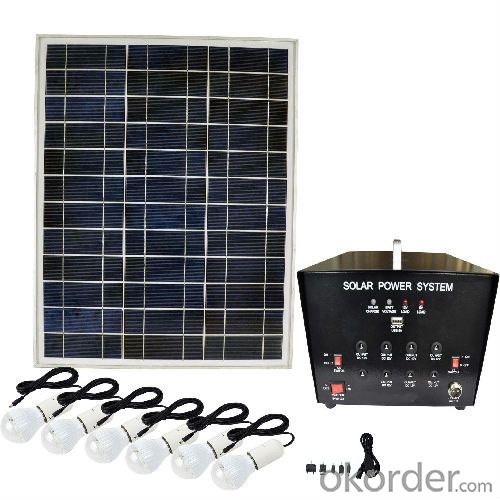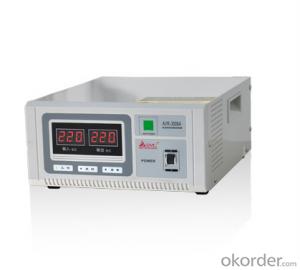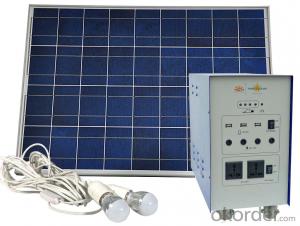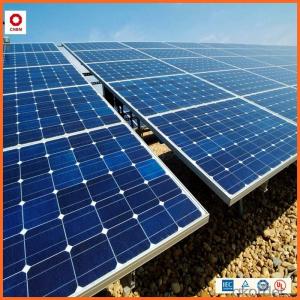DC Solar Light System Solar System W/Radio for Home Use
- Loading Port:
- Shanghai
- Payment Terms:
- TT or LC
- Min Order Qty:
- 300 watt
- Supply Capability:
- 200000 watt/month
OKorder Service Pledge
OKorder Financial Service
You Might Also Like
| Quick Details | |||||
| Specification: | Mini | Application: | Home | Output Voltage (V): | 12V DC & 5V DC |
| Load Power (W): | 10W | Solar Power (W): | 10W | Work Time (h): | About 28 hours |
| Color: | White+Green | Dimension(mm): | L240 x W130 x H215 | Net weight(kg): | 4.25 |
| Packaging & Delivery | |||||
| Packaging Detail: | Standard export package or according to customer's requirement. | ||||
| Delivery Detail: | 15-20 work days depending on order quantity | ||||
Mini Solar Home Light Systems
Mini solar home light system includes Solar cell modules, solar battery, solar controller , LED lamps and USB charger cable. It is one system which is special designed to meet customers' demand of electricity when they go to camping or there’s no lights. It can be applied to any areas that electricity is in short supply. Use very widely. It can charge for Cell phones, lights, mp3 and other DC charging products.
Product Features:
Environmental protection: solar product does not produce pollutants, without noise, create a green, clean, comfortable living environment.
Convenience: It is featured with compact configuration, small in size, light in weight and easy to carry.
Main Functions:
1. Built in FM radio and MP3 player
2. Battery power indicator
3. Overloading protection
4. Overvoltage protection
5. Overheat protection
6. Short circuit protection
7. 4* DC12V output and 2* 5V USB output
Specifications:
Model | ISS10-7Q-R |
Solar panel power | 18V 10W(8m solar cable) |
Battery capacity | 12V 7AH (lead acid) |
Solar panel charging time | 5.5 hours (effective sunlight) |
DC Output | 4*12VDC terminals / 2*5V(500mA) USB |
FM radio & Mp3 player | Yes |
Certificate | CE & RoHS |
Dimensions of system box | L240*W130*H215mm |
Net weight of system box | 4.25Kg |
Appearance color | White + Green |
Dimensions of solar panel | L355*W285*H17mm |
Net Weight of solar panel | 1.25Kg |
Dimensions of battery | L150*W65*H95mm |
Net Weight of battery | 2.0Kg |
Products guarantee as below:
Main machine guarantee time: 1 year limited warranty (lifetime: more 10years)
Battery guarantee time: 1 year (lifetime: 2-3years)
Solar panel guarantee time: 5 years
OEM/ODM available:
Tell us the requirements and price range you desire, we will bright you best performance product against your budget.
Loads and use time reference:
| Load | Load Power | Duration of single load | Remarks |
| LED lamps | 3 Watt * 2 | Appr. 18H | Different Location, different charging time. |
| 2 Cell phones | 2.5 Watt * 2 | Appr. 20H | |
| A mini fan | 2.5 Watt | Appr. 40H | |
| All above | 13.5Watts | Appr. 8H |

- Q:What is the impact of tree shade on the performance of solar panels?
- The impact of tree shade on the performance of solar panels can be significant. When solar panels are shaded by trees, their ability to convert sunlight into electricity is greatly reduced. This is because shade prevents direct sunlight from reaching the panels, reducing their overall efficiency. Shade on solar panels can create a phenomenon known as "partial shading," where only a portion of the panel is shaded. In this case, the shaded portion of the panel acts as a barrier, preventing the unshaded portion from producing electricity at its maximum capacity. This results in a decrease in the overall energy production of the solar panel system. Tree shade can also cause an imbalance in the output of solar panels that are connected in series. When one panel is shaded, it can significantly reduce the performance of the entire series, as the shaded panel acts as a bottleneck for the flow of electricity. This can lead to a decrease in the overall energy generation of the solar system. It is worth mentioning that the impact of tree shade on solar panels depends on various factors such as the intensity and duration of the shade, the orientation and tilt angle of the panels, and the efficiency of the panels themselves. Additionally, advancements in solar panel technology, such as the use of bypass diodes in modern systems, can help mitigate the negative effects of shading to some extent. To optimize the performance of solar panels in the presence of tree shade, it is important to consider the placement and design of the solar panel system. This may involve trimming or removing trees that cast shade on the panels, adjusting the tilt angle of the panels to minimize shade impact, or considering alternative locations for the installation of the panels where shade is less of a concern. Overall, tree shade can have a significant impact on the performance of solar panels, reducing their efficiency and energy production. It is crucial to carefully consider the effects of shade when planning and designing a solar panel installation to maximize its effectiveness.
- Q:How do solar energy systems contribute to reducing noise pollution compared to traditional power generation methods?
- Solar energy systems contribute to reducing noise pollution compared to traditional power generation methods because they do not require noisy machinery like generators or turbines to produce electricity. Instead, solar panels silently convert sunlight into energy, resulting in a much quieter and peaceful environment.
- Q:What happens to excess electricity generated by a solar energy system?
- Excess electricity generated by a solar energy system is typically fed back into the grid, allowing other consumers to benefit from the surplus power. This process is known as net metering, where the excess energy is credited to the system owner's account and can be used to offset future electricity bills.
- Q:Can solar energy systems be used in areas with limited sunlight?
- Yes, solar energy systems can still be used in areas with limited sunlight. While areas with abundant sunlight are ideal for solar energy generation, advancements in solar technology have made it possible to generate electricity even in areas with less sunlight. These systems can still produce a significant amount of energy by capturing and converting sunlight, albeit at a reduced efficiency. Additionally, energy storage solutions such as batteries can help store excess energy for use during periods of low sunlight.
- Q:Solar power generation system suitable for home, how much is the cost of a set?
- Configuration of a household solar power system is about ten thousand to $twenty thousand
- Q:Are there any aesthetic considerations when installing a solar energy system?
- Yes, there are aesthetic considerations when installing a solar energy system. These include the visual impact of the system on the building or landscape, the placement and orientation of solar panels to maximize efficiency and minimize visibility, and the integration of the system with the existing architectural design.
- Q:Can solar energy systems be installed on sports stadiums?
- Yes, solar energy systems can be installed on sports stadiums. Many sports stadiums around the world have successfully implemented solar energy systems to generate renewable and clean electricity. These systems are typically installed on the roofs of stadiums or in nearby open areas to maximize sunlight exposure. By harnessing solar power, sports stadiums can reduce their reliance on fossil fuels, lower their carbon footprint, and contribute to a more sustainable future.
- Q:How do solar energy systems impact job training and skill development?
- Solar energy systems have a significant impact on job training and skill development by creating new employment opportunities and fostering the need for specialized skills. The installation, maintenance, and operation of solar panels require trained professionals, leading to the growth of jobs in the renewable energy sector. Moreover, the increasing demand for solar energy systems has prompted the development of training programs and educational resources, enabling individuals to acquire the necessary skills and expertise. Consequently, solar energy systems play a crucial role in enhancing job training and skill development, contributing to the growth of a sustainable and green workforce.
- Q:Can solar energy systems be used for powering electric vehicle charging pads?
- Certainly, solar energy systems have the capability to power electric vehicle charging pads. Sunlight can be harnessed and transformed into electricity through the installation of solar panels on rooftops or open areas. Consequently, this generated electricity can be utilized to operate the charging pads for electric vehicles. By incorporating solar energy, we not only diminish our reliance on fossil fuels but also mitigate the discharge of greenhouse gases associated with charging electric vehicles using grid electricity. Moreover, solar-powered charging pads can be implemented in remote or off-grid areas where access to the power grid is restricted or nonexistent. This renders solar energy systems an environmentally sustainable and favorable solution for energizing electric vehicle charging pads.
- Q:Can solar energy systems be used to power vehicles?
- Yes, solar energy systems can be used to power vehicles. Solar panels can be installed on vehicles to convert sunlight into electricity, which can then be used to charge the vehicle's batteries. This renewable energy source provides an environmentally friendly alternative to traditional fossil fuels, reducing both carbon emissions and reliance on non-renewable resources. However, the efficiency and range of solar-powered vehicles are still being improved, and they are currently more commonly used for short-distance travel or as supplemental power sources.
1. Manufacturer Overview |
|
|---|---|
| Location | |
| Year Established | |
| Annual Output Value | |
| Main Markets | |
| Company Certifications | |
2. Manufacturer Certificates |
|
|---|---|
| a) Certification Name | |
| Range | |
| Reference | |
| Validity Period | |
3. Manufacturer Capability |
|
|---|---|
| a)Trade Capacity | |
| Nearest Port | |
| Export Percentage | |
| No.of Employees in Trade Department | |
| Language Spoken: | |
| b)Factory Information | |
| Factory Size: | |
| No. of Production Lines | |
| Contract Manufacturing | |
| Product Price Range | |
Send your message to us
DC Solar Light System Solar System W/Radio for Home Use
- Loading Port:
- Shanghai
- Payment Terms:
- TT or LC
- Min Order Qty:
- 300 watt
- Supply Capability:
- 200000 watt/month
OKorder Service Pledge
OKorder Financial Service
Similar products
New products
Hot products
Hot Searches
Related keywords































